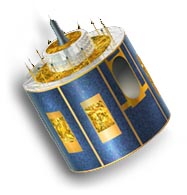Dataset
MSG: RGB 'False Colour' 321 product daytime imagery over Western Europe
Abstract
The Meteosat Second Generation (MSG) satellites, operated by EUMETSAT (The European Organisation for the Exploitation of Meteorological Satellites), provide almost continuous imagery to meteorologists and researchers in Europe and around the world. These include visible, infra-red, water vapour, High Resolution Visible (HRV) images and derived cloud top height, cloud top temperature, fog, snow detection and volcanic ash products. These images are available for a range of geographical areas.
This dataset contains RGB 'False Colour' 321 product images from MSG satellites over western Europe. Imagery available from March 2005 onwards at a frequency of 15 minutes (some are hourly) and are at least 24 hours old.
RGB images are composite images generated by combining two or more channels and displaying in colour. The naming convention describes which channel is assigned to the red, green and blue colours. For example RGB 321 means that channel 3 (1.6 micron) is on the red, channel 2 (0.8 micron) is on the green and channel 1 (0.6 micron) is on the blue. This combination can then highlight different physical features through the differing amounts of red, green and blue and hence give a unique colour to that feature. In this case, turquoise clouds contain ice crystals, whilst white clouds are water clouds (inc. fog). Vegetation creates a green signal and sandy areas are pink. Snow covered ground is turquoise.
Note: a change in product can be seen from a change to software implemented on 25/11/2013 where the scaling and gamma correction of the R, G, and B channels were tuned to give an improved image, in effect lightening the brighter colours in the image image.
The geographic extent for images within this datasets is available via the linked documentation 'MSG satellite imagery product geographic area details'. Each MSG imagery product area can be referenced from the third and fourth character of the image product name giving in the filename. E.g. for EEAO11 the corresponding geographic details can be found under the entry for area code 'AO' (i.e West Africa).
Details
| Previous Info: |
No news update for this record
|
|---|---|
| Previously used record identifiers: |
No related previous identifiers.
|
| Access rules: |
Restricted data: please submit an application using the REQUEST ACCESS link for access.
Use of these data is covered by the following licence(s): https://artefacts.ceda.ac.uk/licences/specific_licences/msg.pdf When using these data you must cite them correctly using the citation given on the CEDA Data Catalogue record. |
| Data lineage: |
Data obtained by satellite from March 2005, prepared by the Met Office and stored in the BADC archive. |
| Data Quality: |
Operational satellite data.
|
| File Format: |
Images are GIF formatted
|
Process overview
Instrument/Platform pairings
| Spinning Enhanced Visible and InfraRed Imager - SEVIRI-1 | Deployed on: Meteosat Second Generation 1 (MSG-1) or METEOSAT-8 |
Mobile platform operations
| Mobile Platform Operation 1 | Mobile Platform Operation for: Meteosat Second Generation 1 (MSG-1) or METEOSAT-8 |
Computation Element: 1
| Title | Meteosat Second Generation 1 (MSG-1) or METEOSAT-8 |
| Abstract | Deployed on Meteosat Second Generation 1 (MSG-1) or METEOSAT-8. Launched on 28 August 2002, the first Meteosat Second Generation (MSG) satellite became operational on 29 January 2004, when it was redesignated Meteosat-8. Since then it has continuously returned highly detailed imagery of Europe, the North Atlantic and Africa every 15 minutes, for operational use by meteorologists. MSG-1 has a nominal lifetime of seven years. |
| Input Description | None |
| Output Description | None |
| Software Reference | None |
| Output Description | None |
- long_name: Snow
- gcmd_url: http://vocab.ndg.nerc.ac.uk/term/P041/4/G290
- gcmd_keyword: EARTH SCIENCE > Atmosphere > Precipitation > Snow
- names: http://vocab.ndg.nerc.ac.uk/term/P041/4/G290, EARTH SCIENCE > Atmosphere > Precipitation > Snow
Co-ordinate Variables
Temporal Range
2005-09-06T23:00:00
Ongoing
Geographic Extent
62.7685° |
||
-44.7900° |
41.7618° |
|
32.2608° |

